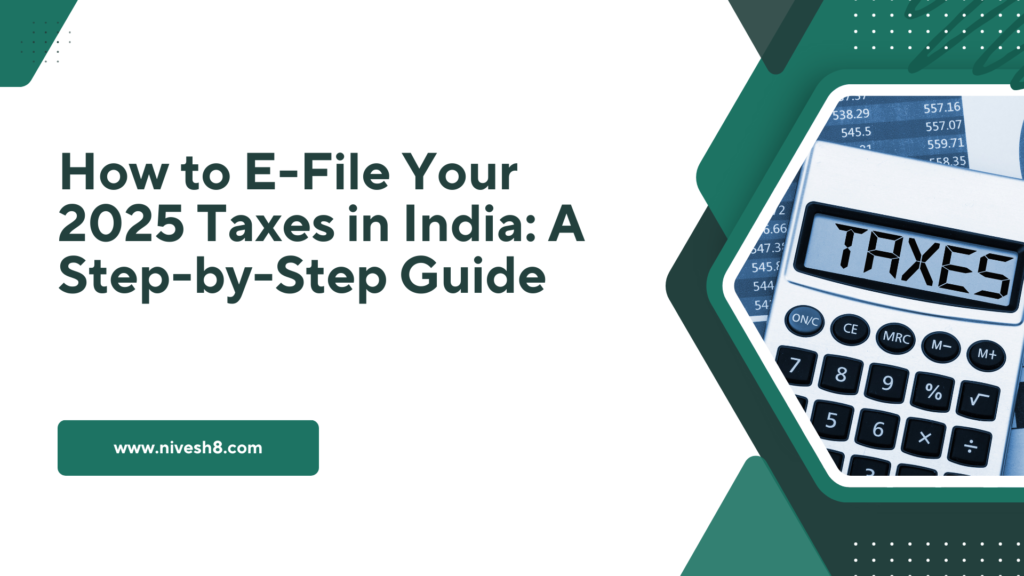E-filing—that is, electronically filing your income tax return—is one quick and easy approach to handle your tax responsibilities. It’s time to get ready for the e-filing process for the Assessment Year (AY) 2025-26 as the financial year 2024-25 shuts. Negotiating India’s e-filing system will be easier with this simple guide in hand.
E-filing: Definition and Justification
E-filing is the online process of submitting your income tax return. It speeds processing and replaces the actual documentation need. An official portal run by the Income Tax Department of India lets users securely e-file their returns.
For What Reason Would You Want E-Filing?
- Convenience: File your taxes at any moment and anywhere without going to a tax office.
- Accuracy: The online system reduces mistakes by means of real-time data validation.
- Speed: Faster processing of returns and faster refunds makes speed more than in-hand filing.
- Security: Safely forward your ITR and get back right away.
Important Dates for 2025 E-Filing Taxes
- Beginning on April 1, 2025 – The Income Tax Department normally lets e-filing for the new assessment year begin from this date.
- Due Date for Individuals: July 31, 2025 – For those not calling for an audit.
- October 15, 2025 – Due date for companies needing audits.
E-File Your 2025 Taxes: Steps
1. Get the Required Records
- PAN Card: Your permanent account number.
- Form 16: Specifies your tax and pay deductions from your company.
- Bank Statements: For other financial records including interest income.
- Documentation: Pertaining to tax-saving investments under sections like 80C, 80D, etc., proves investments.
- Aadhaar Card: For name confirmation.
2. Register via E-Filing Portal
- View the official Income Tax Department e-filing portal at https://www.incometax.gov.in/iec/foportal/.
- Click “Register” and supply your user ID—your PAN.
- Select a password then input the necessary data to complete the registration.
3. Access the Portal Log-On
- Type your PAN and password to identify yourself.
- Solve the captcha then click “Login.”
4. Choose ITR Form
- ITR Form 1 (Sahaj): For salaried individuals whose income falls less than ₹50 lakh.
- ITR-3 or ITR-4 (Sugam): For those with either business income or capital gains.
- The portal provides direction on selecting the correct form based on your income sources.
5. Fill in the Details
- Online: Advised for simpler returns; you can straight fill and submit the form on the portal.
- Offline: Download the pertinent ITR tool—Excel or Java—enter data offline, create a JSON file, then post it to the portal.
- Review pre-filled address, PAN, and name from personal data.
- Enter income details including house property, capital gains, pay, and other sources.
- Under several sections, depending on your investments, claim deductions.
- The system will figure your tax due automatically.
6. Check and Submit
- Review every entered detail very closely.
- Use the “Validate” tool to hunt errors.
- Once verified, click “Submit.”
7. Verification of Your Return
You have to confirm your return using one of the following once you file:
- Get an OTP on the mobile number Aadhaar registered with.
- Check by means of the net banking portal of your bank.
- Create from your pre-verified bank account your electronic verification code (EVC).
- If unable to e-verify, forward a signed copy of ITR-V (acknowledgment) to the Bengaluru Centralized Processing Center (CPC).
Guidelines for an Optimal E-Filing Experience
- Protection of Your Credentials: Make sure your e-filing portal’s login details remain private.
- Update Your Contact Information: Keeping your current mobile number and email address will enable you to get quick alerts.
- Check Pre-Filled Information: Update as needed using Form 26AS and past returns.
- Save the Acknowledgment: For future reference following successful submission and verification.
E-filing your 2025 taxes is simple and comes with many advantages—convenience, accuracy, faster refunds, among others. Following the above guidance and keeping to key deadlines guarantees a hassle-free tax filing experience. Review your material before submission and keep all relevant records close by to help avoid any issues.



